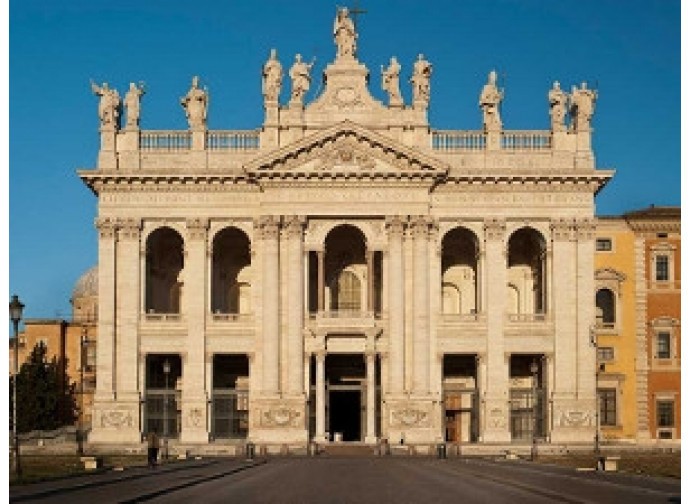Dedication of the Lateran Basilica
The Lateran Basilica is the oldest in the West and above all, being the cathedral of Rome, the most important in all Christianity. This is evident from the title with which it is honoured and that sums up the reason for its commemoration today: Omnium Urbis et Orbis Ecclesiarum Mater et Caput, Mother and Head of all the Churches of Rome and the World.

The Lateran Basilica is the oldest in the West and above all, being the cathedral of Rome, the most important in all Christianity. This is evident from the title with which it is honoured and that sums up the reason for its commemoration today: Omnium Urbis et Orbis Ecclesiarum Mater et Caput, Mother and Head of all the Churches of Rome and the World.
Its full name is “Papal Archbasilica of the Most Holy Saviour and Saints John the Baptist and the Evangelist in the Lateran”. The official dedication to the Most Holy Saviour dates back to St Sylvester I (pontiff from 314 to 335), while the foundation of the basilica probably took place under the pontificate of his predecessor, St Miltiades (311-314). The latter received the land as a gift from Constantine as a sign of gratitude to God for the victory in the battle of the Milvian Bridge (Ponte Milvio) in 312, preceded by the vision of the Cross and the famous motto: In hoc signo vinces (Latin translation of the corresponding Greek words that appeared to the Emperor), “in this sign you will win”. From the pontificate of St Gregory the Great the dedication was extended to Saints John the Baptist and the Evangelist: an oratory attached to the baptistery was dedicated to each of them, and became definitive in the 12th Century.
The consecration of the Lateran Basilica in the 4th Century came at a crucial historical stage for Christianity, marked by the edicts of 311 and 313. It was the time of the end of the persecutions, which until then, amidst ups and downs, had forced Christians to gather mostly in private houses for the celebration of the Eucharist. With the freedom of worship, church after church sprang up. From that moment on, the Patriarchio Costantiniano (the present Lateran Palace), adjacent to the basilica, became the residence of the popes and remained as such until the beginning of the 14th century, when the papacy was transferred to Avignon. The ancient basilica founded at the time of Constantine has been rebuilt several times. Five Ecumenical Councils were held within its walls, from Lateran I of 1123 to Lateran V of 1512-1517.
As the cathedral of Rome, it is in this basilica that the Pope's investiture on the Roman Cathedra is celebrated as Peter's successor and therefore pastor on earth of the universal Church. “This is the task of all Peter's Successors: to be the guide in the profession of faith in Christ, Son of the living God. The Chair of Rome is above all the Seat of this belief”, recalled Benedict XVI on the day of his inauguration. “The One who sits on the Chair of Peter must remember the Lord's words to Simon Peter at the Last Supper: ...You in turn must strengthen your brothers (Lk 22: 32). The one who holds the office of the Petrine ministry must be aware that he is a frail and weak human being - just as his own powers are frail and weak - and is constantly in need of purification and conversion. But he can also be aware that the power to strengthen his brethren in the faith and keep them united in the confession of the Crucified and Risen Christ comes from the Lord.”
Learn more:
Historical notes on the Lateran Basilica (in Italian)
Homily at Mass of Possession of the Roman Chair of Benedict XVI (7 May 2005)


